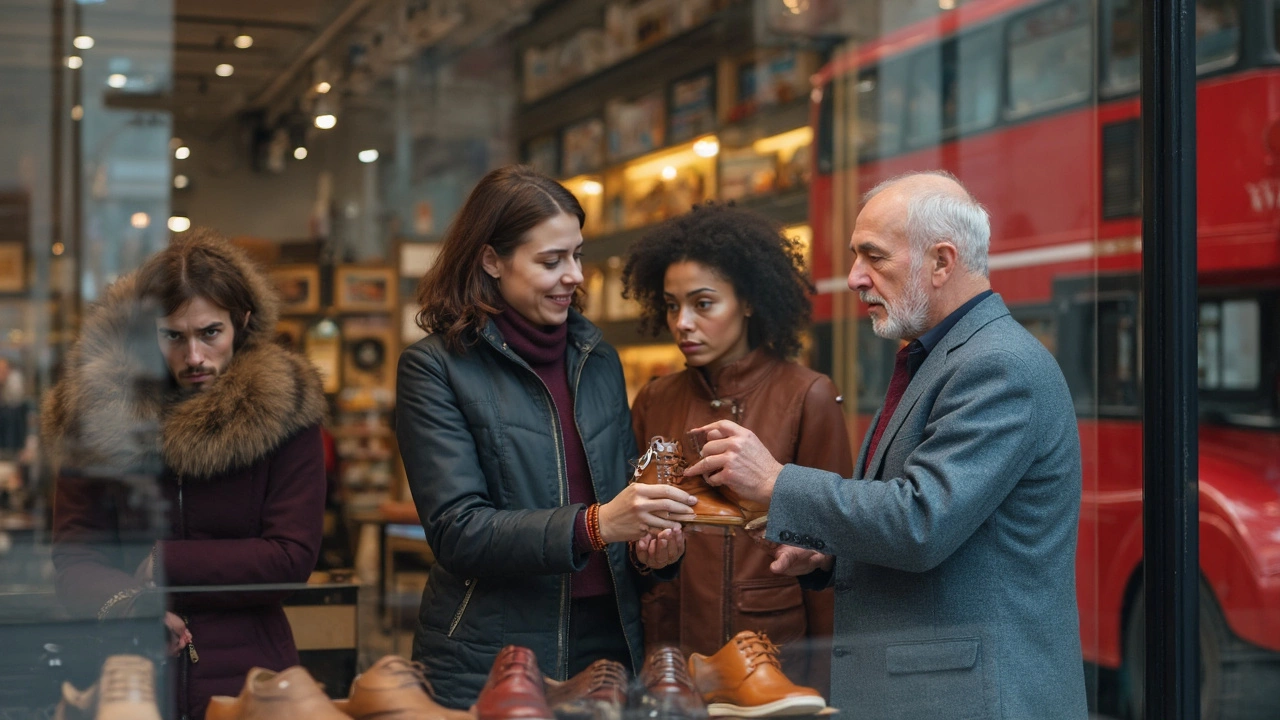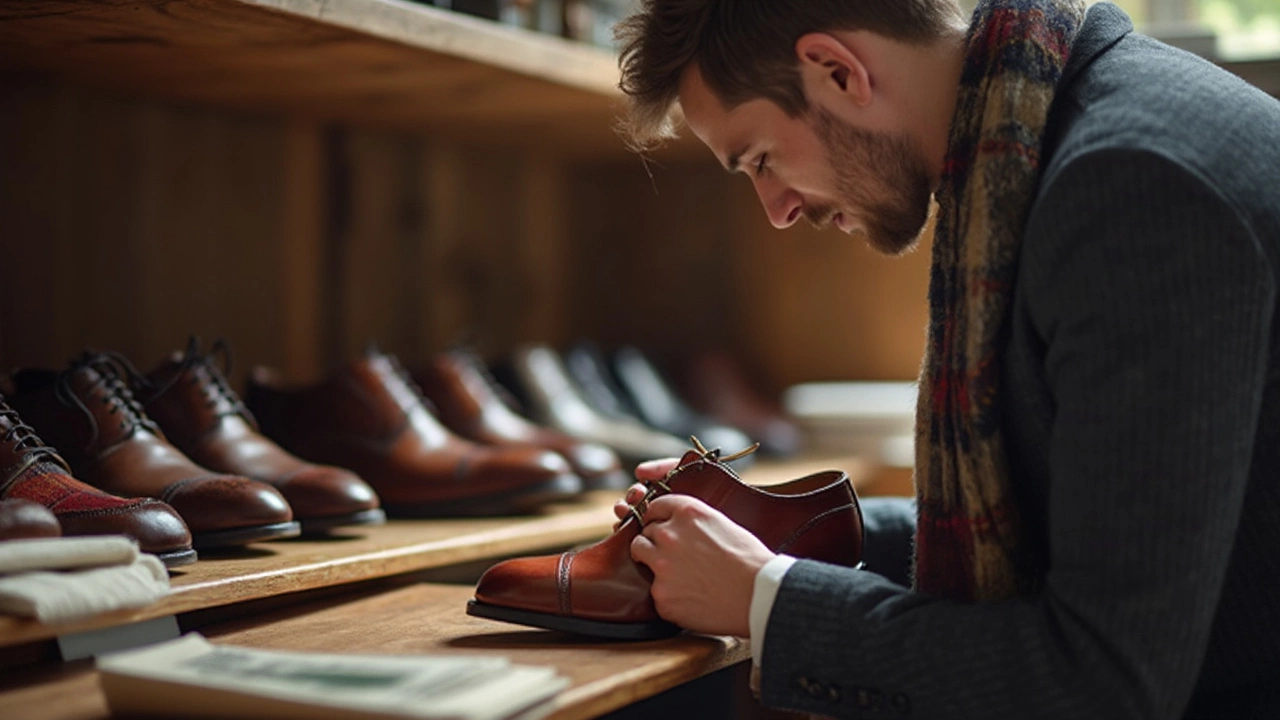If you’re shopping for leather shoes, you’ll notice prices can jump from $60 to $500 without much explanation. So what actually makes one brand better than another? Spoiler: It’s not always the name or the price tag.
Think about it—some brands use real full-grain leather, which means the hide is barely touched and gets better with age. Others slap on a ‘genuine leather’ label, but the material is thin, glued together, and cracks in a year. The stitching, sole, and even the way shoes fit can totally change how they look after a month of wear.
Big brands like Allen Edmonds, Red Wing, Clarks, and Church’s get named a lot, but not every pair in their line is built the same way. There are hidden gems and overrated letdowns in almost every store. And did you know that shoes “made in Italy” aren’t always hand-stitched or high quality? Sometimes those labels just mean they were finished in a warehouse there.
If you’re tired of wasting money on shoes that flatten out, flake, or hurt your feet, there are clues to spot real value—no fancy jargon required. We’ll get into what to check, which brands deliver, and hacks to keep your shoes looking fresh years down the line.
- What Really Sets Brands Apart
- Top Leather Shoe Brands Compared
- What to Look for When Buying
- Tips for Making Leather Shoes Last
What Really Sets Brands Apart
Shopping for leather shoes isn’t just about the logo on the insole. There are actually real, nitty-gritty differences behind how brands make their shoes. The biggest factor? The quality of the leather itself. Full-grain leather, for example, keeps the original grain from the hide and holds up way better than anything labeled “genuine leather,” which is usually split scraps pressed together. Good brands use thick, supple material that just looks and feels sturdy.
Construction matters, too. You’ll see words like “Goodyear welted” or “Blake stitched” tossed around. Goodyear welted shoes have this rim-like layer that gets stitched right to the sole—makes them easier to resole and way more durable for everyday wear. Cheaper options are mostly glued together, so once the sole starts peeling off, it’s game over. Here’s a quick breakdown of common construction types:
- Goodyear welted: Long-lasting, resoleable, pricier up front but cheaper over time.
- Blake stitched: Found in sleeker shoes; flexible but less water-resistant.
- Cemented or glued: Cheap to buy, quick to fall apart.
Thread and lining make a difference, too. Some brands cut corners by using plastic or cardboard for the inner structure. Premium names usually line shoes with soft calfskin or even lambskin, which keeps the inside from getting gross and sweaty. Look inside a high-end shoe and you’ll rarely see fraying or loose threads.
Then, there’s where and how they're made. Twenty years ago, “Made in England” or “Made in Italy” basically guaranteed good stuff, but now, factories worldwide make both awesome and awful shoes. It’s really about which suppliers and factories the brand uses—not just the location on the label.
Price doesn’t always line up with quality. Some brands charge more because of their name and marketing. Others keep quiet, spend less on ads, and use their savings for better materials. Here’s a table with well-known brands and quick facts about what they focus on:
| Brand | Leather Type | Construction | Typical Price Range |
|---|---|---|---|
| Allen Edmonds | Full-grain | Goodyear welted | $250-$425 |
| Clarks | Split/grain, some genuine | Cemented/Blake | $100-$180 |
| Red Wing | Full-grain (oil-tanned) | Goodyear welted | $270-$350 |
| Church's | Full-grain | Goodyear welted | $500-$800 |
| Thursday Boot Co. | Full-grain | Goodyear welted | $160-$220 |
If you’re after solid value, don’t stare at the price or location—check what the shoe is actually made of, how it’s put together, and if it fits and feels right for you. These basics are what really set brands apart from each other in the shoe aisle.
Top Leather Shoe Brands Compared
If you’re standing in a store or scrolling online, it’s easy to get overwhelmed by all the brands promising the best leather shoes. Let’s strip it down to facts and real-world performance.
- Allen Edmonds: Built in the USA and around since 1922, Allen Edmonds is famous for durability. Many of their styles use Goodyear welt construction, so you can resole them (sometimes several times) instead of throwing them out. Their Park Avenue model is a popular office shoe and has stuck around for years—guys have literally worn them for decades with regular care.
- Red Wing: If you want shoes that double as boots for work or the weekend, Red Wing is everywhere for a reason. Hardcore American leather, thick soles, and you’ll see them on everyone from motorcycle riders to baristas. They age well (think cool scuffs, not embarrassing peeling) and are known for holding up even with abuse.
- Clarks: You probably know them for those iconic desert boots—comfy out of the box, lighter than most, and good for folks walking a ton. They don’t last as long as Red Wing or Allen Edmonds, but they’re affordable and better than most big box brands in the same price range.
- Church’s: A solid UK brand with a high-end vibe. They’re not cheap, but if you’re going for classic style and want leather that actually gets compliments, they do it right. Look for shoes actually made in their Northampton factory—those are the winners.
- Meermin: A newer brand from Spain, but they’re getting known fast for good value. You get full-grain leather, sturdy build, and the price is a sweet spot—not cheap, not wild.
Here’s a quick comparison of some popular models and what you get for your money:
| Brand | Popular Model | Avg. Price (USD) | Leather Type | Resoleable? |
|---|---|---|---|---|
| Allen Edmonds | Park Avenue | 425 | Full-grain calfskin | Yes |
| Red Wing | Iron Ranger | 350 | Oil-tanned leather | Yes |
| Clarks | Desert Boot | 170 | Suede/Leather | No |
| Church’s | Consul | 730 | Polished binder calf | Yes |
| Meermin | Classic Oxford | 230 | Full-grain calf | Yes |
If you care about resale or sustainability, shoes like Allen Edmonds and Red Wing are stand-outs because you can rejuvenate them several times. If you want style that stands out, Church’s and Meermin look sharp but cost more. On a budget? Clarks gives you legit leather and comfort for less.
Don’t fall for noise—real quality in leather shoes is about the build, not the hype. Check where the shoes are made, if the leather is full-grain, and whether you’ll be able to fix them instead of tossing them in a year. That’s where your money really counts.

What to Look for When Buying
The leather shoe aisle can make your head spin. Everywhere you look, there’s something claiming to be premium, hand-crafted, or “Italian.” But labels can be misleading, and price doesn’t always match up with quality. Here’s how to spot the good stuff—so you’re not stuck with flimsy shoes that fall apart after one season.
The most important thing is to check the actual leather quality. Full-grain leather is the gold standard—it’s tough, ages well, and forms to your feet. Top-grain is next best, slightly sanded but still solid. Watch out for “genuine leather” (that’s code for blended scraps). The difference? Full-grain might look less shiny in the store, but it’ll look better and hold up longer.
Construction is a game changer. Ever heard of ‘Goodyear welted’ shoes? The sole is literally stitched, not glued, making them easier to resole and way more durable. Shoes just glued together are cheaper, but you’ll spot the difference as soon as they get wet or scuffed. A stitched sole means you’re paying for work that lasts.
Sizing and comfort aren’t just something you deal with—they matter right away. Quality leather stretches and molds to your feet, but you shouldn’t be miserable at first wear. Toe box too tight? Heel slipping? Don’t settle. If you buy in-store, try them on with socks you’d actually wear. If online, double-check sizing guides; brands don’t always match up.
Take a second to check details too—things like stitching, lining, and the feel of the sole. Sloppy threads or a thin liner are dead giveaways for shortcuts in the factory. You want shoes that feel sturdy, not fragile. Solid metal eyelets, a grippy outside, and even the smell (it should be a clean leather scent, not plastic) tell you a lot.
"Investing in quality leather shoes pays off over time. Look for full-grain or top-grain leather paired with stitched construction—it’s a combo that outlasts trends and heavy use." — John Cutts, veteran footwear designer
Here’s a quick table showing the main differences in shoe materials so you can see what you’re getting into:
| Leather Type | Durability | Price Range | Common Use |
|---|---|---|---|
| Full-grain | 10+ years | $$$ | High-end dress/formal shoes |
| Top-grain | 5-8 years | $$ | Mid-range office/casual |
| Genuine leather | 2-4 years | $ | Budget/fast fashion |
- Leather shoes with stitched soles last longer and look better as they age, while glued ones usually wear out fast.
- Check for clean, tight stitching and sturdy hardware like metal eyelets or thick laces.
- If you can bend the sole easily with two fingers or see glue seepage, walk away.
- Avoid "bonded" or "corrected grain" labels—they’re often made with leather dust mixed with plastic.
When in doubt, ask questions. Brands that make good shoes usually love to talk about their materials and construction methods. If the salesperson dodges your questions, that’s an answer in itself.
Tips for Making Leather Shoes Last
If you want your leather shoes to survive more than just one season, you need a routine. The good news? It’s not rocket science—and you don’t need a suitcase full of products.
- Leather shoes really hate water. If you get caught in the rain, let them dry at room temperature. Never put them next to a heater or blast them with a hairdryer—heat will mess up the leather for good.
- Shoe trees are a game changer. They don’t just help hold the shape. If you pop cedar shoe trees in after every wear, they absorb moisture and help prevent stinky shoes. They last forever, so they're a solid investment.
- Brush off dirt and dust every time you wear them. It sounds basic, but even a soft brush or cloth helps stop grime from grinding into the leather.
- Use a proper leather conditioner now and then. Most folks only reach for polish, but conditioner actually feeds the leather so it won’t crack or dry out. About once a month is plenty if you wear your shoes regularly.
- Rotating your shoes makes a big difference. If you wear the same pair every day, they won’t get a chance to dry out. Swapping between pairs lets them breathe and last way longer.
- If you spot salt stains in the winter, wipe them off as soon as possible with a little bit of vinegar and water (just a damp cloth, not soaking wet). Salt can eat straight through leather pretty fast.
- Finally, don’t skip on a rubber sole protector if you walk a lot. You don’t have to ruin their style, but a thin rubber cover on the sole means less slippage and less wear—especially if you’re pounding city pavements.
Put all this together, and even a basic pair can look surprisingly good for years. Whether you’ve splurged or gone budget, a little care goes further than most people think.

